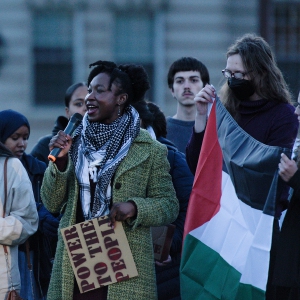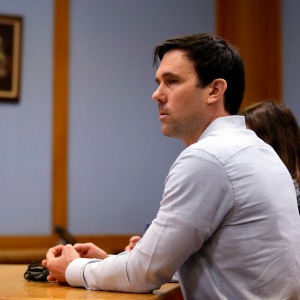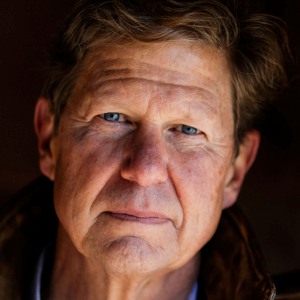Editorial: America’s ever-growing gun appetite
| Published: 03-06-2023 10:05 AM |
New Hampshire Public Radio recentlyreported on a firearms training session conducted in a state park by Rainbow Reload, a New Hampshire LGBTQ gun club that is one of a number throughout the nation. “If the world is dangerous, then you have to be dangerous back,” explained an organizer of the session.
A little poking around on the internet also revealed the existence of John Brown Gun Clubs, one of which is located in Vermont. These are conceived as a left-wing antidote to violent white supremacist groups. It’s not surprising that some people who are the target of virulent hatred and violent threats are taking up arms against a sea of troubles. But we do ask whether an uneasy peace predicated on an armed standoff is the best that a divided America can hope for.
This is apparently of no concern to the U.S. Supreme Court’s conservative majority. As we alluded to in this space last week, gun rights and regulations are among the areas of the law in which the court has created chaos and confusion. Last June, it overturned century-old New York State regulations on carrying firearms, finding that law-abiding citizens have the right “to carry handguns publicly for their self-defense.”
Justice Clarence Thomas articulated a new standard for lower courts to use: “When the Second Amendment’s plain text covers an individual’s conduct, the Constitution presumptively protects that conduct. The government must then justify its regulation by demonstrating that it is consistent with the Nation’s historical tradition of firearm regulation.”
As we noted at the time, there are at least three problems with this. The first is that the high court cherry-picked the historical evidence to reach its conclusion, and thus invited lower courts to do the same. Second, that test requires judges to become historians, a role for which they are mostly not trained. Third, it demands that judges adhere to legal and moral codes that may no longer make sense in the modern world.
The result has been at least 100 federal court decisions in at least 25 states in which judges have sought to apply that new standard. Many of those rulings are wildly inconsistent. Some have subsequently been overturned by appellate courts, which themselves have contradicted each other. A judge in Texas interpreted the Supreme Court’s ruling to mean that it was presumptively unconstitutional to prohibit felons from possessing firearms. In West Virginia, a state law barring the carrying of firearms with altered or obliterated serial numbers was also deemed unconstitutional. A federal law that bars people who are under domestic violence restraining orders from carrying firearms was struck down by an appeals court that hears cases from Texas, Louisiana and Mississippi.
In Indiana, federal Judge Robert L. Miller basically threw up his hands. He wrote that he hoped he misunderstood the Supreme Court ruling, because if he didn’t, “most of the body of law Congress has developed to protect both public safety and the right to bear arms” might well be unconstitutional. (In case you are wondering, Miller was appointed to the bench by Ronald Reagan.)
How this all sorts out is beyond our poor powers of prediction. Probably most of the questions will eventually end up back at the Supreme Court for resolution. But it seems safe to assume that the future legal landscape will be one in which guns will be even more prevalent, in more hands and in more public places than ever. Only in America.
Article continues after...
Yesterday's Most Read Articles
 Herd departs Hartford’s last remaining dairy farm
Herd departs Hartford’s last remaining dairy farm
 At Dartmouth, hundreds protest ongoing war in Gaza and express support for academic freedom
At Dartmouth, hundreds protest ongoing war in Gaza and express support for academic freedom
 Claremont removes former police officer accused of threats from city committees
Claremont removes former police officer accused of threats from city committees
 Over Easy: ‘A breakfast without a newspaper is a horse without a saddle’
Over Easy: ‘A breakfast without a newspaper is a horse without a saddle’
This is an alarming development at a time when the country is so sharply divided and emotions are on a hair trigger, and one that threatens the democratic process. How so? The carrying of firearms by counter-protesters at political demonstrations has exploded. Last year, a New York Times analysis of 700 armed demonstrations found that at about 77% of them, people openly carrying guns represented right-wing viewpoints, including hostility to LGBTQ rights and abortion access and opposition to racial-justice rallies, and in support of former President Trump’s big lie that he won the 2020 election.
This situation calls into question whether the fundamental First Amendment right “peacefully to assemble, and to petition the Government for a redress of grievances” can be freely and vigorously exercised in the face of armed intimidation. Perhaps the Supreme Court will take up that question while it tries to clean up the mess it made last year.

 Editorial: Parker parole a reminder of how violence reshapes our lives
Editorial: Parker parole a reminder of how violence reshapes our lives Editorial: Chris Sununu’s moral vacuum
Editorial: Chris Sununu’s moral vacuum Editorial: Gambling tarnishes America’s sporting life
Editorial: Gambling tarnishes America’s sporting life By the Way: A white nationalist’s many mistruths
By the Way: A white nationalist’s many mistruths
